Shaftless Spiral Conveyors
The Shaftless Spiral Conveyor is an alternative concept to the traditional shafted screw conveyor. Material is conveyed by an extra-heavy-duty Shaftless Screws that slides on a low-friction, wear-resistant liner inside the Conveyors trough housing.
The U-section troughs, which are longitudinally divided, are manufactured in carbon steel or in 304 L / 316 L stainless steel, including an appropriate surface treatment. Fabricated parts except the screw, which is ultra-heavy-duty, are of the medium-heavy-duty type. The cross section of the lower part of the trough is slightly wider than the side channels to allow for the liner to be inserted in the lower trough part. After complete assembly of the trough the liner is kept in place by the upper trough side channels. At one trough end there is a vertical or flush-type outlet. At the drive end the Screw Conveyors is equipped with an end plate holding the end bearing assembly with flanged shaft coupling with the screw. The drive unit installed suits the application.
Function
The Shaftless Spiral offers a larger volume capacity and the possibility of handling particularly difficult materials such as those that tend to become tangled up or those that present highly variable particle size. Construction material properties, oversize thickness, as well as a special manufacturing process make the spiral highly resistant and extremely durable. Due to the absence of intermediate bearings, obstacle-free material handling is guaranteed. The completely enclosed trough prevents any material leakage. Trough covers with appropriate gaskets enable odour-free operation and form a barrier to any atmospheric agents to enter the system. At the same time the conveyor offers maximum access to the inside for inspection and cleaning. Maintenance is reduced to the minimum due to a small number of components. There is a vast choice of liners depending on the specific material characteristics.
The main sectors of application are: wastewater treatment, sugarhouse rejects, fish industry, solid waste treatment, fruit and vegetable processing plants, beverage industry, pulp and paper, chemical industry, food industry in general, meat processing plants, abattoirsor slaughterhouses, restaurants, canteens, catering in general.
